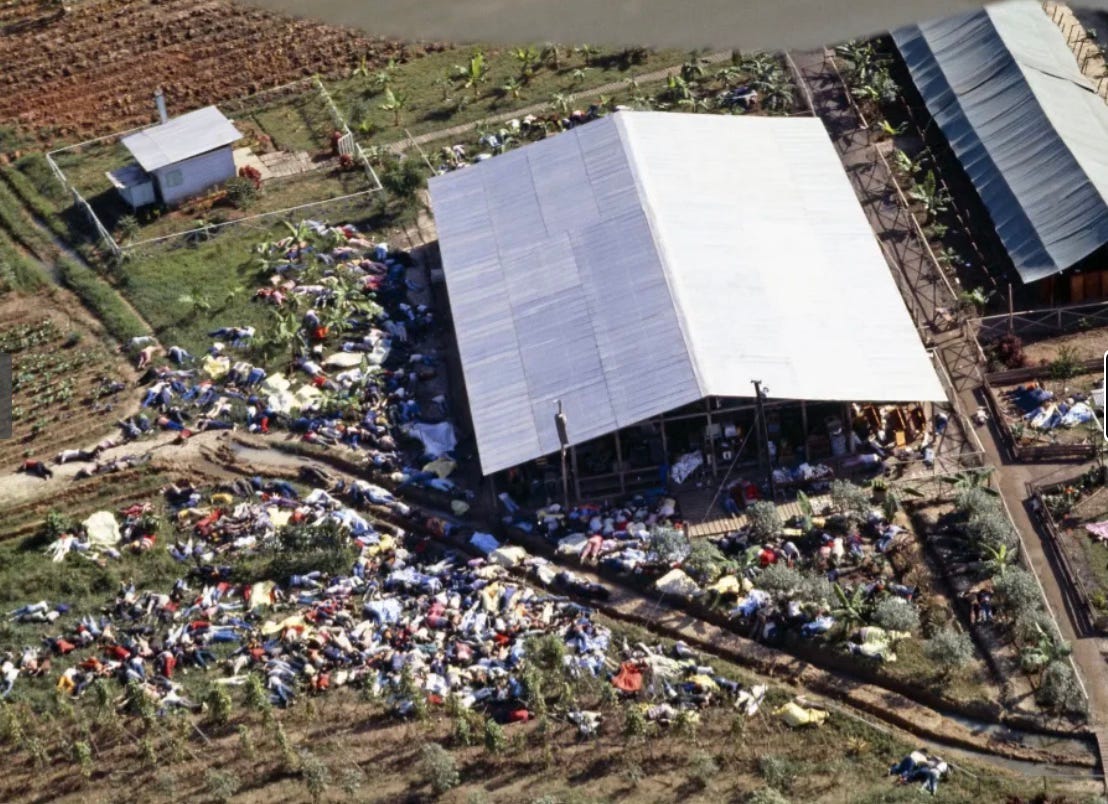45 years after Jonestown
A Santa Barbara witness shares her painful memory of the event and her family's close call with tragedy... and murder.

November 18 is the 45th anniversary of the second-largest mass murder in American history after 9/11. Over 900 Americans died in a single non-natural event in the remote jungle commune at Jonestown, Guyana, a third of whom were children. The Jonestown massacre is by far the largest single mass killing of American children in our nation’s history.
However, for some reason, we don’t hold candlelight vigils for the 304 children murdered, 100 of them just seven years old and younger. No rallies, no moment of silence, no flags at half-mast, no trending #hashtag. It is as if this gruesome scene doesn’t quite fit the proper narrative for a public remembrance.
Move on.
Nothing to see here.
The 900+ victims of Jonestown don’t get much in the way of thoughts and prayers either. Other than a small memorial in an Oakland cemetery, there are no other known memorials erected for the victims anywhere in the U.S. At the Redwood Valley People’s Temple compound where many of these victims first met, there is not a plaque, makeshift memorial, or notice. This mass murder is not taught in our local schools or even referenced on so-called historical websites that ostensibly track mass American homicides. No one talks about banning the primary murder weapon delivery system. Our collective memory of the Jonestown massacre revolves around the historically inaccurate “Drink the Kool-Aid” meme the 900+ victims drank – or were forced to swallow – a cheap, purple South American knockoff mixed with cyanide.
Santa Barbara’s Sheridan Rosenberg did not memory-hole the Jim Jones cult or the Jonestown massacre it spawned.
She witnessed it.
“They smelled like big city folk”
As a young girl, Sheridan grew up in the small blue-collar rural town of Redwood Valley, near Ukiah, California with her mother and grandmother. At around seven years old, Sheridan remembers meeting the charismatic Jim Jones and his wife Marceline as they went door to door drumming up interest in their Peoples Temple church just down the road. “They smelled like big city folk”, Sheridan recalls of the couple’s immaculate clothes, of Marceline’s freshly permed hair, and Jim Jones’ cologne.
Over the next half dozen years, Jim Jones and his followers enmeshed themselves deeply in Redwood Valley as a progressive church where Jones’ sermons focused on equality and tolerance. Sheridan remembers her mother dressing up to attend the Temple’s non-alcoholic dances. Temple membership pervaded their small-town society. The local police and many employees of the Ukiah General Hospital, where Sheridan’s mother also worked, were Temple members. While in Redwood Valley, Jim Jones secured a job as a history teacher.
The first sign of trouble came when the Temple’s soft-touch recruitment methods became more coercive. Sheridan’s grandmother refused to allow Sheridan’s mother to accept membership in the People’s Temple. Sheridan never learned the source of her grandmother’s prescience, but she does recall the result. Upon returning home from San Francisco one night, they found “the front door wide open, and all the drawers and cupboards thrown open. All our possessions were thrown around the house. We were robbed by the Temple members,” recalls Sheridan. “We spent that night freezing and in terror.”
Eventually, the People’s Temple relocated to San Francisco, where Jones and his army of Temple “get out the vote” members proved critical in getting “the People’s Mayor,” Democrat George Moscone, elected in a tight race. After the votes were counted, Jones was rewarded with the position of Chairman of the San Francisco Housing Authority Commission, a powerful post that expanded his influence.
Marxist revolutionaries Angela Davis and Huey Newton of the Black Panthers gave full-throated support to Jim Jones and the People’s Temple. A powerful dynasty of California Democrats including Willie Brown, Jerry Brown, and Harvey Milk circled tightly around Jones’s orbit until ultimately Jones and his members fled from San Francisco and into the South American country of Guyana. This sudden move to Guyana in 1977 occurred on the eve of the publication of a revealing exposé of Jones’ authoritarian, drug-addled, sexually abusive practices.
Explaining why Jonestown Massacre victims are not memorialized, Sheridan posits it was “Shame: lots of shame”. She says that at the time many tried to “help expose the People’s Temple and get people out. But It fell on deaf ears until it was too late.”
In large part, the interconnections between Jones and the emerging group of Progressive San Francisco politicians muzzled complaints. He got them votes; they gave him political protection. “It’s long overdue,” Sheridan reflects, “that we remember the victims. It appeared to be a mass suicide, but really it was a massacre many years in the making.”
When asked what lesson she gleaned as a witness to this tragedy, she pauses. Then, with tears welling up in her eyes, she responds, “I have a deep and painful understanding of the militant, morbid, Marxist ideology in practice.
“It never ends differently and it never ends well.
“Ever.”



Was Kamala involved?
I remember the horror of that day. I’m so glad your family avoided this catastrophe, but grieve for the families caught up in it. At the time, it was all over the news, but it does seem buried now. The progressive marxists don’t want this generation to know.